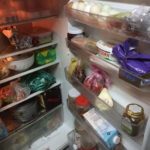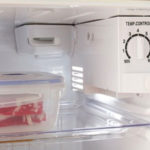Refrigerator is an electrical appliance that almost every household has, and some households even have multiple refrigerators. It helps us store and preserve food better, so we don’t have to go to the market every day. Whether you are the main homemaker in the house or not, almost everyone opens the refrigerator every day.
Although this device is so familiar, not everyone understands it well. Until now, many people still don’t know the function of the water tray behind the refrigerator and whether this part should be cleaned or not.
What is the function of the water tray behind the refrigerator?
Moisture in the refrigerator, under appropriate conditions, will condense into water droplets on the evaporator and then flow into the water collection tray, and then flow out into the water tray.
 The water tray is placed behind the refrigerator, below the condenser, to speed up the evaporation process of water and avoid water overflowing. Therefore, you don’t need to empty the tray regularly.
The water tray is placed behind the refrigerator, below the condenser, to speed up the evaporation process of water and avoid water overflowing. Therefore, you don’t need to empty the tray regularly.
When should the water tray behind the refrigerator be cleaned?
Basically, you don’t need to empty the water tray behind the refrigerator because it is the cool water from the defrosting that flows down. When the compressor is hot, the water tray will also be hot and evaporate, so the water will not overflow anymore.
If you notice a bad smell behind the refrigerator, too much water in the drain pan, or dirty water, you can remove it and clean the tray.
However, to make the refrigerator operate most efficiently, you need to know how to clean the refrigerator and the water tray behind it correctly. Please follow the following steps to clean the refrigerator:
– Unplug the refrigerator.
– Remove all food from the refrigerator.
– Remove and clean the shelves inside the refrigerator.
– Clean the inside of the refrigerator.
– Clean the outside of the refrigerator.
– Clean the water drain pan behind the refrigerator.
– Replace the shelves that were removed earlier, then rearrange the food in the refrigerator and plug it in.
The water tray behind the refrigerator serves to collect water when the refrigerator defrosts. The water in the tray helps cool the compressor of the refrigerator because the temperature of the compressor is usually higher than the ambient temperature. If the water tray is full to the point where the water overflows, then your refrigerator has a defrost problem. Call a technician to check and fix it.
Mistakes when using the refrigerator that waste electricity
Mr. Chu Ngoc Vu – Head of Planning Warranty, Technical Service Center, Kangaroo Corporation, pointed out the common mistakes that people make when using refrigerators.
Keep the refrigerator close to the wall
In general, the refrigerator’s condenser (heat exchanger) is designed on the side or back of the refrigerator. Therefore, if the refrigerator is placed in a tight space, close to the wall, it may be difficult for the condenser to dissipate heat. Over time, the refrigerator’s cold compartment will be less cold, and the refrigerator will have to run longer to reach the desired temperature.
According to the manufacturer’s recommendation, the refrigerator’s position needs to be well-ventilated, dry, and the surfaces of the refrigerator need to be at least 20cm away from the surrounding surfaces.
Keep the refrigerator close to heat sources
Similarly, keeping the refrigerator close to walls/shelves or near heat sources can cause the refrigerator to consume more energy.
Specifically, when placed near heat sources such as gas stoves, ovens… it will make the refrigerator less efficient due to the heat dissipation of the condenser, gradually reducing the cooling efficiency.
Put hot food in the refrigerator
The habit of putting hot food in the refrigerator to cool it quickly will increase the temperature inside the refrigerator, causing the refrigerator to operate at a higher power or longer operating time. This will result in higher energy consumption than normal.
Put too much food in the refrigerator
Putting too much food in the refrigerator will reduce the circulation of cold air in the refrigerator, and the food placed in the middle will not come into contact with the cold air, making the refrigerated food unevenly cooled. This can lead to food spoilage as well as a decrease in the refrigerator’s cooling efficiency.
The refrigerator compartment should only contain a maximum of 80% of the capacity and should be arranged neatly so that the cold air can reach each food item for optimal preservation.
Leave too many empty spaces in the refrigerator compartment
Contrary to having too much food in the compartment, not utilizing the full capacity of the refrigerator for food preservation will also result in higher energy consumption for the household.
Many households nowadays prefer to use large-capacity refrigerators but do not fully utilize the allowed capacity, and each time the refrigerator door is opened, more heat is lost compared to refrigerators with more food stored.
The solution to this is for each household to choose the refrigerator capacity depending on the number of family members or depending on the intended use of each family.
Constantly opening the refrigerator door
Continuous and prolonged opening of the refrigerator door will cause heat loss in the refrigerator, causing the refrigerator to operate at maximum capacity to recover the lost heat or operate for a longer time. This will result in higher energy consumption.
According to VTC.vn
Is Refrigerated Leftovers Linked to an Increased Risk of Cancer?
Dr. Lam Van Man, Head of Research, Development and Technology Transfer Department of the Institute of Safety Food, has warned of the risk of food poisoning when reheating leftovers from the refrigerator. But what should we be aware of when it comes to the possibility of these leftovers causing cancer? Here, we explore what the experts have to say on the matter and offer some tips for safe eating.




































